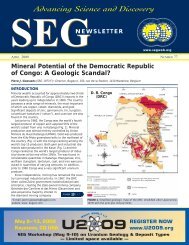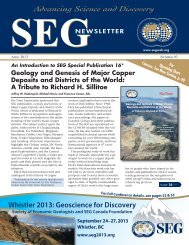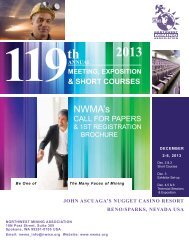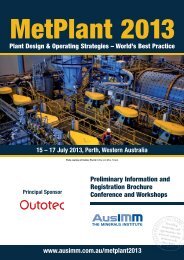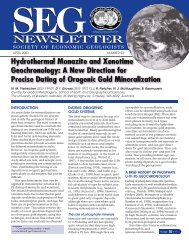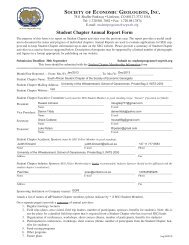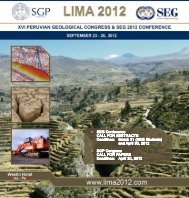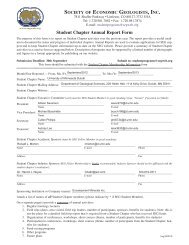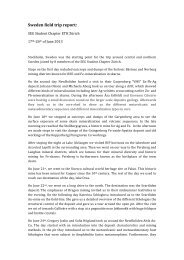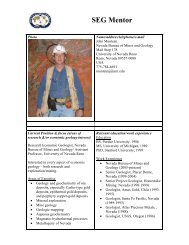SEG - Society of Economic Geologists
SEG - Society of Economic Geologists
SEG - Society of Economic Geologists
Create successful ePaper yourself
Turn your PDF publications into a flip-book with our unique Google optimized e-Paper software.
JULY 2012 • No 90 <strong>SEG</strong> NEWSLETTER 43<br />
EXPLORATION REVIEWS<br />
Notice: Views expressed in the Exploration Reviews do not necessarily reflect those <strong>of</strong> the <strong>Society</strong> <strong>of</strong> <strong>Economic</strong><br />
<strong>Geologists</strong>, Inc., and columnists are solely responsible for ascertaining that the information in this section is correct.<br />
To read additional exploration reviews for countries, please go online to the <strong>SEG</strong> Newsletter supplement.<br />
ALASKA<br />
Regional Correspondent:<br />
Curtis J. Freeman (<strong>SEG</strong> 1996)<br />
Avalon Development Corp.<br />
P.O. Box 80268<br />
Fairbanks, AK 99708<br />
Tel.: 1.907-457-5159, Fax: 1.907-455-8069<br />
E-mail: avalon@alaska.net<br />
Website: www.avalonalaska.com<br />
The winds <strong>of</strong> change are once again<br />
blowing across Alaska’s mineral industry,<br />
not only because the industry is into<br />
another busy summer season, but<br />
because the mining investment climate<br />
has rapidly turned from cautiously<br />
bullish to decidedly bearish. The sea<br />
change occurred steadily and without a<br />
lot <strong>of</strong> fanfare between mid-January and<br />
mid-March. As is always the case, good<br />
projects continue to advance. Those that<br />
are drilling and adding resources or moving<br />
through advanced exploration and<br />
development stages are enjoying a significant<br />
funding advantage over earlier<br />
stage exploration projects. The result,<br />
exemplified by the entry <strong>of</strong> two new<br />
companies acquiring Alaska joint venture<br />
interests over the last month, is a buyer’s<br />
market for early and mid-stage exploration<br />
projects. Mergers and/or acquisitions<br />
<strong>of</strong> more advanced level projects or<br />
companies can be expected over the<br />
coming months. That’s all well and good<br />
if you happen to have 5 million tonnes<br />
<strong>of</strong> copper or 20 million ounces <strong>of</strong> gold,<br />
but what about the rest <strong>of</strong> us poor saps<br />
with a few good drill holes or a highgrade<br />
outcrop and a load <strong>of</strong> …blue sky?<br />
I heard the solution to this problem at<br />
a recent mining company presentation.<br />
The concept was so simple, it nearly<br />
evaded me: sometimes it is wiser to do<br />
less with less! Brilliant, eh?! Obvious, perhaps,<br />
but we all know <strong>of</strong> projects that are<br />
being stretched so thin (aka, trying to<br />
doing more with less) that the quality <strong>of</strong><br />
the resulting product is suspect. We are<br />
in danger <strong>of</strong> being caught by a trap we<br />
have created for ourselves, wherein every<br />
program, every year, is expected to be<br />
bigger and better than the previous one.<br />
With increasing frequency and<br />
increasing litigation, companies are<br />
being punished severely by shareholders<br />
for advocating for a smaller drilling<br />
program or a less ambitious feasibility<br />
study. Since negative reinforcement is a<br />
powerful motivator, the desire to not<br />
get beheaded by shareholders causes<br />
companies to forecast ever more optimistic<br />
results. Inevitably, expectations<br />
reach stratospheric levels and then<br />
somebody notices that the Emperor has<br />
no clothes. At that point, it will be too<br />
late to do less with less. But there is an<br />
upside here: not all drip-fed projects are<br />
created equal. Some <strong>of</strong> the properties<br />
damaged by the more-for-less syndrome<br />
are in fact, high quality mines in the<br />
making. Recognizing those opportunities<br />
is a challenge but, is it any more<br />
challenging than creating new wealth<br />
out <strong>of</strong> a never-before explored patch <strong>of</strong><br />
desert or mountainside? I don’t think<br />
so either, and that is why we should<br />
expect that both careers and companies<br />
will be won and lost in the coming<br />
months by astute mergers and acquisitions.<br />
As Ayn Rand said, “You can<br />
avoid reality but you can’t avoid the<br />
consequences <strong>of</strong> avoiding reality.”<br />
AUSTRALASIA<br />
Regional Correspondent:<br />
Russell Meares (<strong>SEG</strong> 1996)<br />
Malachite Resources Limited<br />
Sydney, Australia<br />
E-mail: rmeares@malachite.com.au<br />
Website: www.malachite.com.au<br />
With contributions from:<br />
Roger Thomson (<strong>SEG</strong> 1983) –<br />
Western Australia<br />
Lucy Chapman (<strong>SEG</strong> 2000) – Queensland<br />
Tony Christie (<strong>SEG</strong> 1992) – New Zealand<br />
Ge<strong>of</strong>f Green (<strong>SEG</strong> 2000) – Tasmania<br />
Andrew Rowett – South Australia<br />
Bianca Pietrass-Wong – NSW<br />
Steve Russell (<strong>SEG</strong> 2009) – NT<br />
Paul McDonald – Victoria<br />
SUMMARY<br />
The life cycle <strong>of</strong> most mining operations<br />
commences with an exploration discovery,<br />
moving steadily through the mining<br />
phase, then finally into the closing-down<br />
and rehabilitation phase. In the case <strong>of</strong><br />
the Ranger uranium mining operation,<br />
owned by Energy Resources <strong>of</strong> Australia<br />
Ltd (ERA), the company is transitioning<br />
from the mining phase back into a capital-intensive<br />
phase <strong>of</strong> exploration. The<br />
Ranger deposit is located in the Northern<br />
Territory, 250 km east <strong>of</strong> Darwin, and is<br />
totally surrounded by the World Heritage<br />
Listed Kakadu National Park, famous for<br />
its wetlands flora and fauna. The deposit<br />
was discovered in 1969 using airborne<br />
radiometrics, long before the National<br />
Park was declared in 1979, and the<br />
Ranger operation is one <strong>of</strong> the largest<br />
uranium producers in the world, being<br />
one <strong>of</strong> only three mines in the world to<br />
produce in excess <strong>of</strong> 100,000 t <strong>of</strong> uranium<br />
oxide. However, due to the in -<br />
adequate estimation <strong>of</strong> annual rainfall<br />
in the design phase, the mine has con -<br />
tinued to suffer seasonal failures <strong>of</strong> the<br />
surface water management system. This<br />
situation has been exacerbated by a series<br />
<strong>of</strong> record summer wet season rainfall<br />
events over recent years, with the deci -<br />
sion being taken to close and rehabili -<br />
tate the current open pit by the end <strong>of</strong><br />
this year, and to return to the explora -<br />
tion phase (although this explorer owns<br />
a plant, a power station, an airport, and<br />
a town!). The aim is to complete the<br />
exploration and development <strong>of</strong> the<br />
Ranger 3 orebody, which lies at depth<br />
below the current open pit, by late 2015.<br />
Ranger 3 contains an estimated 34,000 t<br />
<strong>of</strong> uranium oxide at a grade <strong>of</strong> 0.34%<br />
uranium oxide, triple that <strong>of</strong> the head<br />
grade <strong>of</strong> the current open pit operation.<br />
The company will invest an estimated<br />
A$120M in constructing a 2.2<br />
km exploration decline to a depth <strong>of</strong><br />
350 m and conducting close-spaced<br />
underground exploration drilling to further<br />
define the Ranger 3 Deeps orebody,<br />
and to explore areas adjacent to<br />
that resource. In addition, ERA is conducting<br />
an extensive three-rig surface<br />
drilling program on prospective and<br />
underexplored areas <strong>of</strong> the Ranger project<br />
area over the period from 2012 to<br />
2014 at an estimated cost <strong>of</strong> A$40M.<br />
This level <strong>of</strong> investment,<br />
to page<br />
and the decision to<br />
44 ...<br />
EXPLORATION REVIEWS



